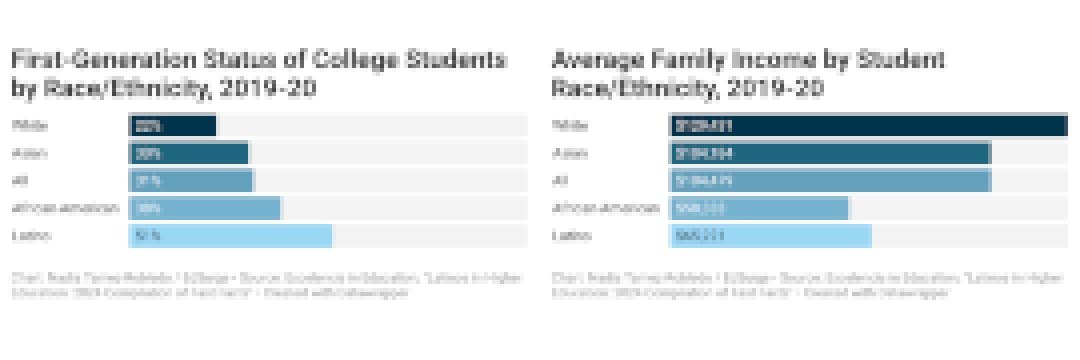What Can Colleges Do Better to Help Latino Students Succeed?

[ad_1]
The number of Latino students who are going to college is on the rise, and they don’t all fit the profile of what institutions might consider the typical freshmen on campus.
They’re more likely to be first-generation, working to support themselves and caring for dependents than other college students, according to a new analysis by Excelencia in Education. The nonprofit researches and promotes policies around Latinos in higher education.
“Our intent in putting this compilation together was to not only clarify the current profile of our students, but hopefully inform and compel thoughts about what more we can do to serve them better and increase the degree attainment,” says Deborah Santiago, the organization’s CEO and co-founder.
Real Life vs. College Life
Half of Latino college students are the first in their family to pursue a higher education degree, meaning they can’t necessarily lean on parents for advice on navigating their new environment. Their families also have lower average incomes than every other group except Black students.
Rather than looking at those characteristics as obstacles, Santiago says colleges have an opportunity to provide “information guardrails” for students who need help understanding essentials like financial aid or the courses they will need to graduate.
More than half of Latino students were enrolled either exclusively part time or had “mixed enrollment,” which the analysis describes as between part-time and full-time enrollment, during the 2019-20 academic year.
That may be in part because many also work while going to college, whether to fund their education or support themselves. According to the analysis, more than one-fifth of Latino students worked 30 to 39 hours per week, while another third worked 40 or more hours.

Santiago says that students who work at least 30 hours per week are more likely to “stop out” and take time off from school to save up more money for tuition. Or they might choose to attend part time to make the cost more manageable.
“All of those are things we know in general can limit the potential of completion,” Santiago says, adding that institutions can respond with strategies like employing those students directly on campus, providing more financial support or having robust online access to support services.
“If [students] have chosen to go to college, they have an educational goal. How do we help them get that?” Santiago says. “And I just think we don’t ask that question enough, because we’re always saying, ‘What do students need to do more of? And what do they need to change?’ I think that’s fine to say that, but we also have to put the onus on institutions and decision-makers.”
Weighing the ‘Opportunity Cost’ of College
While Latinos across the board are earning more degrees, Latinas are outpacing their male peers and now making up 60 percent of Hispanic degree earners.
That’s not to say that Hispanic men are decreasing in degree attainment, Santiago says, but the data illustrates the trade-offs that Latinos have to consider when weighing higher education against joining the workforce after high school.
“If you’re going to school and paying somebody to take classes, as opposed to working and making money, that is an opportunity cost,” Santiago says.
A young Hispanic man who can go into a field like construction and immediately make $25 to $30 per hour may see a good reason to put off college, she explains, while college may seem more attractive to young Latinas facing entry-level wages of $12 to $15 per hour in other fields.
(Latinos overall accounted for nearly one-third of the construction workforce in 2020, according to the U.S. Bureau of Labor Statistics, with women overall making up 1 in 10 construction employees. Weekly full-time wages were nearly $1,000 at the time, roughly four times higher than minimum wage, and about 56 percent of construction employees had a high school diploma or less. )
Then there’s the appeal to some Latinos of a job that’s hands-on, Santiago explains, combined with a lack of Hispanic male role models in higher education, that influence the decision about postsecondary pathways.
The question that institutions should consider, Santiago says, is how can they engage students who seek out a degree after starting off in an industry like construction.
“You can make a good amount of money now, but in five years, you’re probably gonna reach the cap of what you can make,” she says, not to mention the physical toll over time. “So how do you balance that? Will you come back to college after and continue earning and advancing yourself professionally? I think it’s just an understanding of how the opportunities are a little bit different, and how does higher education adjust or adapt to that?”
Supporting Upward Mobility
Another piece of good news from the analysis is that Latinos are entering STEM majors at a rapid pace, with a 44 percent increase in STEM degree attainment from 2015 to 2020.
There’s more that colleges and universities could be doing to help Latino students break into higher-paying jobs, Santiago says. While Latinos had the highest labor force participation of any ethnic group in 2022, they also held an outsized proportion of lower-paying jobs and the smallest share of managerial and professional jobs.
With so many Latino students being first-generation and low-income, Santiago says colleges need a game plan for educating those students about the types of jobs and wages their degrees can command.
“I think the second part is acknowledging that many of us, because we tend to be low-income, might need to start [college] and work concurrently, so we might need to get a certificate,” she says. “The opportunity to continue training rather than thinking of the certificate or the associate degree as terminal — but can it then be credited toward the next degree to go from a phlebotomist to an LVN to an RN? So that there’s clarity about pathways of progression into higher-paying fields.”
And the third factor, Santiago says, falls on employers to expand their networks.
“Too often, employers recruit from the same 20 institutions,” she says. “There are Latinos getting Ph.D.s in electrical engineering. Have you thought to recruit from those campuses, or are you always going to the same three or four? So to me, there’s an opportunity for students, for institutions, for employers to play roles here to better serve.”
[ad_2]
Source link







